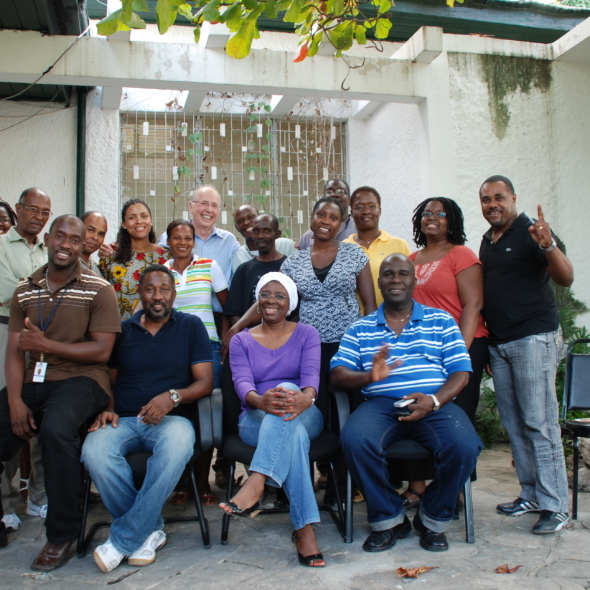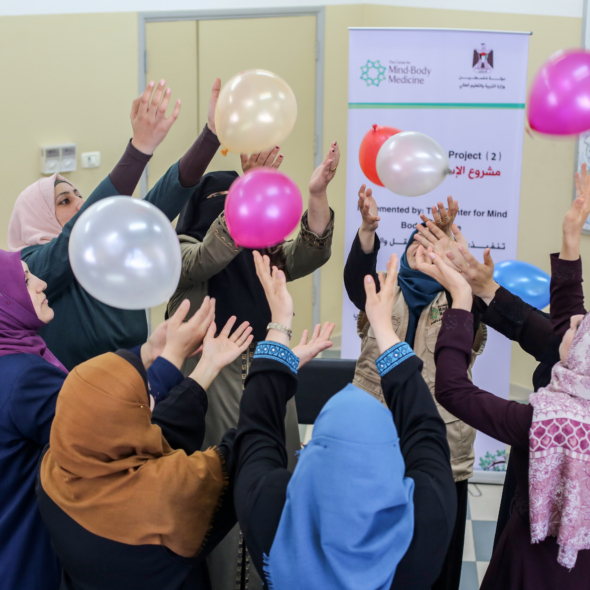We move during the rest of our week in Haiti from one group of health professionals and community leaders to another. It is a slow progress through the traffic jams in Port-Au-Prince’s rubble-narrowed streets, and sometimes even slower over the gorged-out, flooded dirt roads that take us to Bishop Pierre Andre Dumas‘ diocese in Anse-a-Veau, three hours outside the city.
We use a variety of techniques in our workshops, including explanation of the fight-or-flight and stress responses, meditations, guided imagery, and shaking and dancing. We also do a drawing exercise that has been enormously helpful to children and adults in war, post-war, and post-disaster situations, in Kosovo, Gaza, Israel, and New Orleans, and with US military. For a while, everyone—bent over paper, crayons in hand—becomes young, earnest, playful, surprised.
The drawings allow people to tap into their intuition and imagination without effort. As a series of pictures unfolds, they find themselves creating images they’d never imagined, sketching solutions to problems that seemed insoluble.
In Haiti, we guide our groups through three drawings. The first picture is of “yourself,” the second, “you and your greatest problem,” and the third calls for “the solution to that problem.” (We modify the exercise when we use it with children: read my post about using the drawing exercise with Haitian children in the General Hospital.) Afterwards, participants share their drawings in groups of two or three, telling what they see in what they’ve created and how it makes them feel. Then they have the opportunity to share with the entire group.
As you will see, the results are often touching, and almost always surprising.
Here are a few examples and snapshots of the workshops in which they are created:
For L’Institut Haïtien pour la Doctrine Sociale Chrétienne (Haitian Institute for the Christian Social Doctrine)
Such wonderful, accomplished people: 100 of them—physicians, architects, lawyers, police officials, business men and women. All, in this time of crisis, are renewing their commitment to the welfare of those who have suffered even more than they have. They tell us about the terrible sadness—their own, and others—and about unaccustomed irritation that surfaces at home and at work, as if, somehow, angry will could restore what has been lost.
An obstetrician/gynecologist, tall, broad-shouldered, powerful and handsome in a bright, tailored shirt, has come “for rest and peace—I have not slept since January 12th.” He says he works “always” to forget the loss of his house, the deaths in his family—his sister, nieces, nephews—as well as to care for his patients. In his second drawing (a picture of his biggest problem), he is inside a tunnel, tiny as an ant, lost, unable to touch the equally tiny figures outside. In the third (a picture of his problem’s solution), the figures are larger, recognizably human. They are dancing together and he is laughing, “for the first time since the quake.”
For Anse-a-Veau diocese—nuns, priest, lay brothers
Out in the countryside a couple days later, we are meeting with priests, nuns, and lay brothers in Bishop Dumas’ diocese. It’s like rural Africa out here: lush, green and very still, faded pastel cottages with tiny yards in which seeds, sown or thrown, produce a few vegetables and fruits. We begin and end our visit with Bishop Dumas’ blessing and simple ceremonial meals: tiny, boned, tender white fish, rice, beans, greens, fresh lemonade and thick coffee.
The religious, in straight-backed chairs, are as still and elegant as the statues in the porticos of Chartres. They are so attentive, so sweet tempered amidst the flood of suffering, homeless, city people that the earthquake has forced back to the countryside. One priest draws a scene of despair—”The Cross of Death—Good Friday without Easter Sunday,”—and then, in his third picture, much to his amazement, produces a sun that covers the page with radiant yellow. “It’s the sun of freedom. Together we can overcome.”
They dance, too—nuns, brothers, and priests together—as freely and as happily as children. Before we finish in mid-afternoon, another, older priest calls the Bishop from the next diocese. It turns out he would like us to come there.
More soon about another workshop, this time with the Haitian Red Cross staff and volunteers . . .


